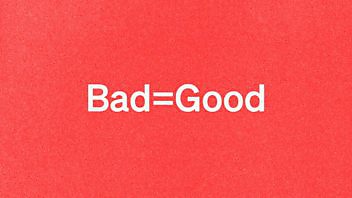There’s a worrying trend that lurks in the background in all marketing departments. A well-intentioned, insidious, glib menace.
It seeps in through the cracks, and dismantles good marketing from the inside.
And it sounds like this:
“This line’s a little negative. Can we try something more…positive?”
The problem
You know good marketing when you see it, right? A solid galvanising idea, wrapped in a wonderfully told story.
But you know what totally ruins a good story? Here, let me show you:
Story A:
Once upon a time there was a small town, sat on a hillside in a remote part of the land.
For years a local warlord has been squeezing the small town for protection money. But this year there has been a famine, the harvest has been poor, and the villagers barely have enough money to feed themselves, let alone pay the warlord. But the warlord doesn’t care. He rolls into town and tells them they have to pay or the village will be razed to the ground. They have one week to pay. The villagers collect every penny they have, but they’ve only got half the money needed. One day, a warrior arrives in the town, looking for somewhere to rest his head on his way through. The village folk ask if he could defend the town. He says he can, but he won’t work for free. They have a decision to make. Do they pay the warrior or do they pay the warlord? They risk it on the warrior.
The rain is pouring. The villagers peek out from behind half-closed doors. The warlord rolls into town, screaming for the villagers to come out and face him. Instead, the warrior walks out into the street and faces the warlord down. They fight.
The warlord is vanquished.
The village becomes famous as the village that took down the warlord. It becomes a thriving hub of tourism and trade. They all live happily ever after.
Story B:
Once upon a time there was a small town, sat on a hillside in a remote part of the land. Nothing bad ever really happens in the village. One day, a warrior arrives in the town, looking for somewhere to rest his head on his way through. The village folk say ‘Oh look, a warrior’. The end.
Now I know I’m being facetious. But the problem’s real.
Take away the bad, and you take away the story.
I don’t know what marketers think is going to happen if we start saying negative things.
That the soft fleshy prospect will prick itself on the sharp edges of a negative idea, get scared, and slither back into its shell. The people reading our marketing are on the internet. The internet. You’ve been on the internet, right?
Of course what’s actually happening is that marketers want prospects to have a positive feeling when they think of whatever the marketer is marketing.
Not that kind of fluff
And that’s a totally understandable impulse. But here’s the thing:
“We sell the world’s best office chair fluffer” doesn’t sell many chair fluffers if people aren’t actively looking for a new chair fluffer.
“There’s a better way to fluff your chair” is talking about the product in a positive way and could sell more chair fluffers than the above, but probably not.
“The way you fluff your chair is bad for your chair. Which is bad for your back, and bad for your bottom-line because you need to replace more chairs more frequently” is negative, but (if true) is the message that will actually promote a sale.
Because (say it with me):
People don’t like change.
Change is hard. It requires active thinking. It requires decision-making, it requires someone raising their hand and saying that they think you should spend company money doing something different.
People will self-motivate a change if their current situation is so bad it’s unsustainable. But that’s rare. Think about the amount of companies you’ve come into contact with where they’re just making do with a system that’s totally insane.
I used to work for a company that made people fax (FAX!) their weekly timesheets, then paid the staff by monthly check, sent by post. This was after 2010. It was insane. But it was how they did things. Would it have been better if they had some sort of automated accounting software? Yes. Would it have saved them time? Yes. Money? Yes. Improved employee satisfaction? Undoubtedly.
But they didn’t do it.
And I can guarantee you that almost every company that you come into contact with has stupid things just like this. And that includes the companies that you’re marketing to. And if you’re marketing something that improves how a company works, it’s probably the exact thing you’re marketing that is their point of stupidity (POS™).
Which means you have to motivate the change.
Change already!
If you want to motivate your prospects to make the decision to buy whatever it is you’re selling, you gotta get their attention. You gotta tell them that the way they’re doing something is wrong. You gotta show them the money it’s costing them (whether that’s ‘here’s the money you could be making’ or ‘here’s the money you’re spending that you shouldn’t be’).
You gotta make the idea of not changing worse than the idea of changing.
And the only way to do that is with something negative. Give the protagonist an antagonist.
If it wasn’t obvious, your solution or product or whatever is the warrior in the story above. You want the audience to relate with the villagers. When your solution rolls into town, the village folk should be astounded at their fortune that you’ve arrived because you are the answer to their problems. Sure, you cost money, but life after you is going to be better than life before you.
And the audience goes ‘Hey, maybe this would work for me too’.
If there’s no warlord, it doesn’t matter how good a warrior you’re selling, the villagers won’t care.
A story for you:
Marketing used to exist on broadcast media, where it was pretty difficult to measure the effectiveness of the campaign. So if stakeholders wanted to just tell positive stories and never say anything negative, it wouldn’t really matter. But then the internet happened, and it became obvious what was working and what wasn’t. So when stories without antagonists and without any bite got released, they flopped, and you knew it. Brave marketers noticed that this was happening, and decided to make a stand. They started including the bad as well as the good in their stories. They became more balanced. More real. More believable. And something remarkable happened. It worked.

Enjoyed this article?
Take part in the discussion








Comments
Dave Vranicar SilverStream LLC / Redwell B2B June 12th, 2019
I just love your stuff. B2B marketers really need to read this. Every B2B salesperson knows, “No pain, no sale.”
But marketers insist on directing everyone’s feet to the sunny side of the street.
No one buys anything in business except to solve a problem. If you can’t talk about problems, you’re going into battle with one arm tied behind your back. Maybe both.
If only B2B marketers knew something about selling. Sigh.
Doug Kessler June 18th, 2019
(Andrew is on hols so Ill answer for him):
Amen, Dave. Let’s start a counter-movement.
I really want to track down the person who wrote the marketing book that says you can never be negative… and beat them with a Nerf bat while singing “Always Look On The Bright Side of Life”.
Jen Havice Make Mention June 20th, 2019
Thank you for this! As someone who helps B2B businesses with their customer research and developing more conversion friendly copy, I have come up against the “We don’t want to sound negative” and (my personal favorite) “We don’t want to talk about problems.” Every time, I find myself muffling a scream and my marketer self dying a little bit inside.
When you don’t talk about the struggle, the circumstances pushing prospects to seek a solution out, you lose an opportunity to help them see how much better life can be after they buy from you. But, more importantly, your prospects don’t see that you understand their pain. And, that’s a lost opportunity for empathy.
Doug Kessler June 28th, 2019
Thanks, Jen. Fantastic point: unrelenting positivity is an empathy fail. Brilliant. Must use that in the next argument!